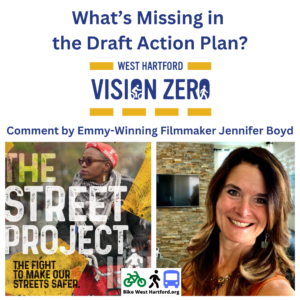
West Hartford resident Jennifer Boyd is an Emmy-winning filmmaker and Director/Producer of The Street Project, an inspiring documentary about the global citizen-led fight to make our streets safer from traffic violence, which you can view on this PBS YouTube channel. She wrote her comments in response to the December 2023 draft of the West Hartford Vision Zero Action Plan and gave us permission to share. We encourage you to email your comments to VisionZero@westhartfordct.gov (and please cc: us at BikeWestHartfordInc@gmail.com) before their public comment period ends on Monday December 18th.
Dear Members of the Vision Zero Team,
Thank you so much for your recent presentation. I truly commend your efforts. Clearly a lot of hard work has gone into the process. Below are some of my thoughts.
1. I could be misinterpreting the document, but there seems to be a general lack of enthusiasm for creating a safe bike infrastructure. Why? If we make biking the fastest way to safely get from point A to point B, people will bike. It’s been proven all over the world. Everyone complains about parking in West Hartford Center, for example. More people will bike if they feel safe doing so, and if the safest routes are the most direct routes.
But it’s not a safe option to merely paint a bike lane between moving cars and the driver’s door. That’s a terrifying option. If I have to worry about a driver’s door opening on my right and moving cars on my left, I won’t bike. I’m concerned others feel the same way. If this style of infrastructure is developed, and not used because people do not feel safe, the assumption will be that people don’t really want to bike. Instead, we need protected bike lanes, and we need to place them next to sidewalks, similar to the design for West Hartford Center that consultants showed us nearly a year ago.
2. There seems to be a great deal of focus on public awareness campaigns, bumper stickers, educational curriculum, videos, social media campaigns, advertising strategies, etc. I’m concerned a lot of money will be spent on flashy campaigns with limited results. Instead, consider the “quick-build” strategy: use limited resources to create temporary materials to test potential infrastructure improvements, and find out what works to reduce car speed and make pedestrians and cyclists safe.
Item J3: Design a bumper sticker campaign? While that’s a nice idea, I don’t think hearts and minds are changed by reading a bumper sticker. Let’s focus first on doing the hard work of changing road design.
Strategy K: I’m curious what you mean by integrating Vision Zero education into West Hartford schools. For decades, automotive companies have funded educational campaigns that essentially blame the victim for their behavior. That’s how the term “jaywalking” began, as described in The Street Project film. I look forward to learning more about this component over the years to come.
Also, please consider that deaths due to distracted pedestrians or cyclists is statistically minimal compared with all other reasons for fatalities (speeding, car design, road design, etc). Yes, we need to address distracted driving, but education alone won’t solve that problem.
We know how to design safe streets that consider human error. That’s what Vision Zero is all about. Let’s focus on actually doing the infrastructure work.
Thank you again for all of the hard work and for the opportunity to comment.
Sincerely,
Jennifer Boyd, West Hartford
